22
Parks to Explore
Irvine PARKS GUIDE
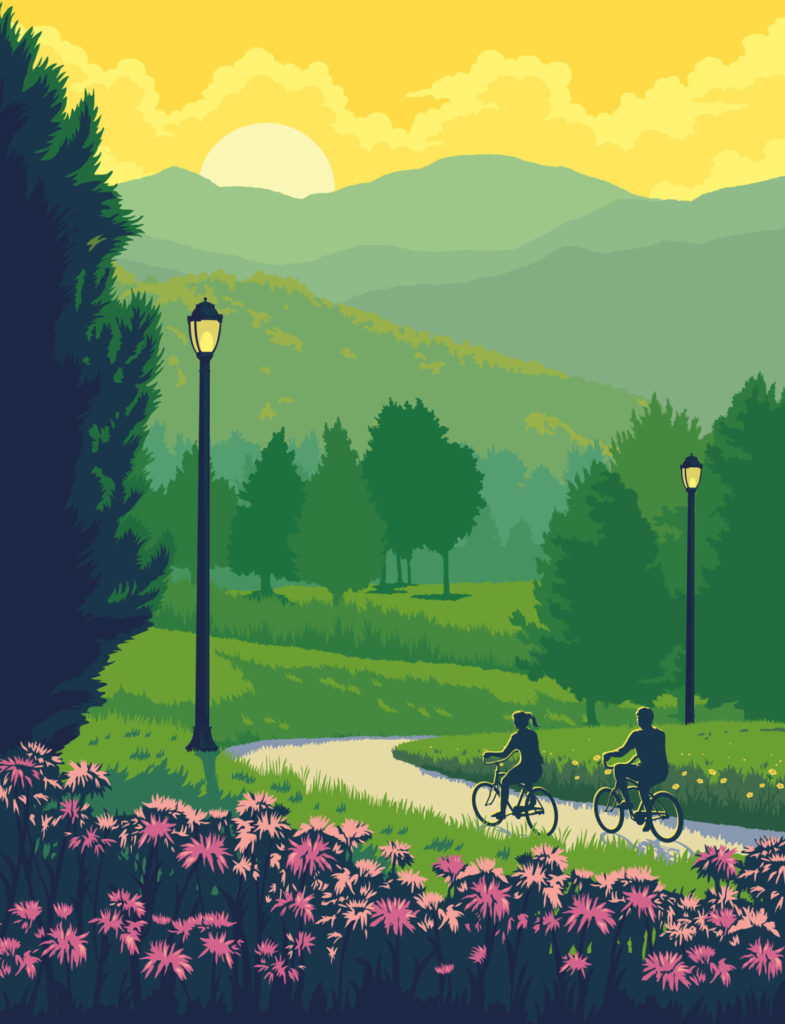
Discover why Irvine’s parks are rated tops in Southern California
See where all 277 Irvine parks are located and why they’re perennially ranked among the top 10 in America by the Trust for Public Land. The Guide also offers tips on 22 parks to visit this weekend – whether you want to hike, bike, swim, find a playground, storm a castle or fly a kite.
1 JEFFREY OPEN SPACE TRAIL
Hike Irvine’s longest park
Enjoy 3.5 miles of uninterrupted meadows, woodlands and trails in the heart of the city. Art installations trace 500 years of local history, while stacked-stone monuments and underpasses give a national park vibe. The 76-acre park is the result of close collaboration between the community and Irvine Company, which developed the $30 million linear park.
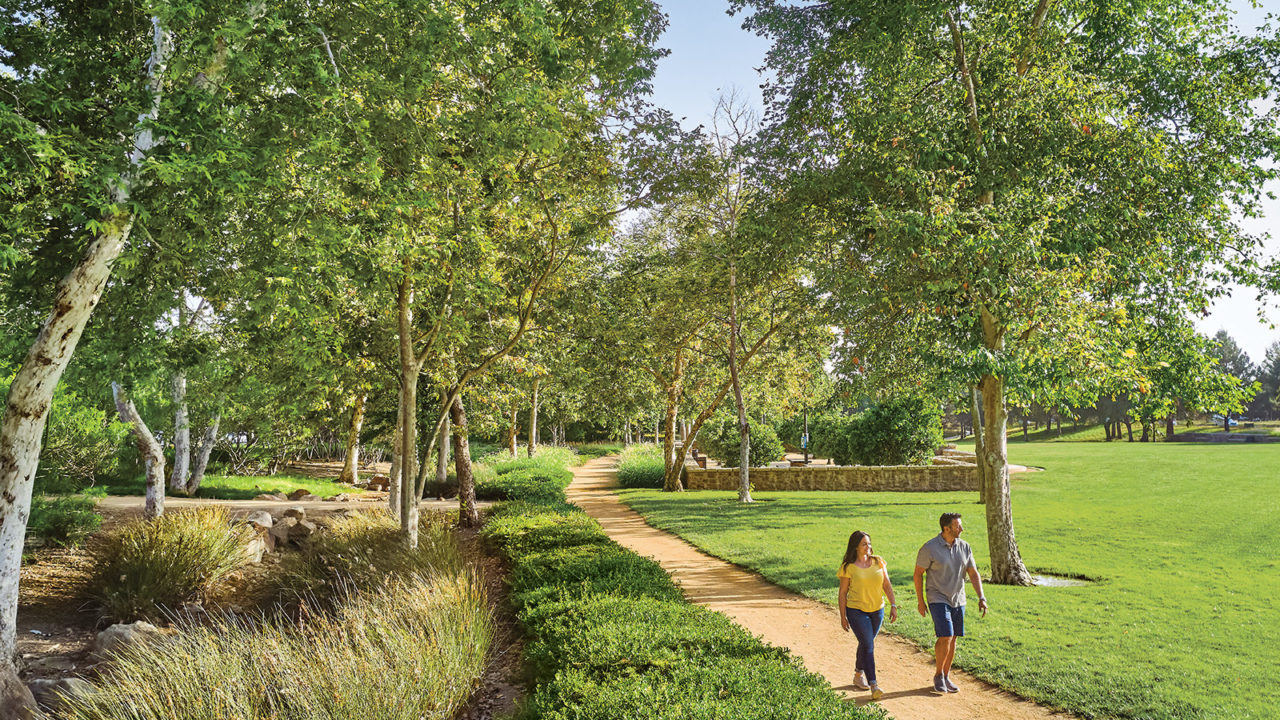
2 HERITAGE COMMUNITY PARK
Cool off this summer
Stroll around the duck pond, let the kids frolic on a splash pad or dive into one of three pools at the adjacent Woollett Aquatics Center. This mid-city park also features a host of sports courts, ballfields, playgrounds and barbecues for picnics. “It is a great spot for the kids to get their wiggles out at the splash pad,” says Irvine mom Lizelle Pais. “You can easily spend a few hours here taking in all the sights and sounds of nature as well as enjoying the playgrounds and walking trails.”
3 QUAIL HILL COMMUNITY PARK
A perfectly planned park
If the Angels ever needed a new home, they could play here – that’s how green, pristine and manicured the sports fields are. The park also features a modern, nature-themed playground with plenty to climb – rocks, logs, a rock wall and ropes – and interpretive signs about local wildlife. The community center offers classes in science, dance and even toddler yoga. And when here, you have access to two popular hikes – the Quail Hill Loop Trail and the Quail Trail, which can take you all the way to Crystal Cove.
4 UNIVERSITY COMMUNITY PARK
Explore the one-of-a-kind Adventure Playground
From its treehouses and climbing poles to oversized Lego bricks and water play, the award-winning Adventure Playground is the stuff of kids’ dreams. For 50 years, it has spurred generations of kids to use their imagination in unstructured play. At the adjacent park, you can play any of seven sports or use the community center to learn dance, skateboarding and more.
5 MIKE WARD COMMUNITY PARK
Enjoy concerts by the lake
Bring a blanket to enjoy several summer concerts, featuring everything from blues to ’80s dance music to country. Or stroll over to South Lake for pictures at the gazebo and shoreline. This 22-acre park features sports courts, including handball and volleyball. When you’re done, grab coffee or lunch at Woodbridge Village Center next door.
6 OAK CREEK COMMUNITY PARK
Summer barbecue time
Let the kids play on one of two playgrounds as you fire up the grill for a barbecue at Oak Creek Park. “I love the rolling grassy hills for playing under the sycamore trees,” says Michele Whiteaker, of funorangecountyparks.com. “Bring a ball to kick around on the field or a Frisbee.” A stroller-friendly, tree-lined path encircles the park.
7 NORTHWOOD COMMUNITY PARK
Storm the castle
Yes, there’s an actual cinder block castle at Northwood Community Park, known as Castle Park. There’s plenty here to capture a child’s imagination, from the rocky moat to the entry tunnel to the fortress on the hill – not to mention a spiral slide, rocking horses and tire swings. The adjacent community park accommodates five sports (baseball, basketball, handball, soccer and tennis), barbecues and picnics, while the adjacent community center offers classes in cooking, karate, singing and Pilates.
8 TURTLE ROCK COMMUNITY PARK
A natural, outdoor classroom
Turtle Rock Park is unique. One moment you’re in a tree-lined park with kids playing T-ball. The next, you’re in a 5-acre nature preserve meandering through woodlands and meadows watching birds over a pond. It’s all here, including tennis, volleyball and baseball. And if that isn’t enough, you’re within steps of two of the city’s most popular hikes: Shady Canyon Trail and Bommer Canyon Nature Trail.
9 CATTLE CAMP AT BOMMER CANYON COMMUNITY PARK
A throwback to The Irvine Ranch’s cowboy days
Put this on your “to-do” list to check out when the city finishes $6 million in improvements to its most iconic spot for weddings, campouts and private events. This 15-acre rustic park in Bommer Canyon is a throwback to the days when cowboys rustled up cattle on The Irvine Ranch. It’s expected to open this summer with new facilities set in a grove of old sycamores.
10 MEADOWOOD NEIGHBORHOOD PARK
Ride the spinning umbrella
Athletes will like the sunken sand-volleyball court, full-court basketball and well-manicured softball and soccer fields. But if you have preschoolers who like action, let them ride the incredible spinning umbrella and wait for the giggles. There’s also a pretty little gazebo with a grass amphitheater and plenty of picnic tables.
11 HARVARD COMMUNITY PARK
An athlete’s dream park
This is a massive, 27-acre park of athletic fields, including seven lighted ball diamonds (with dugouts and bleachers), four lighted soccer fields, lighted batting cages, a concession stand and a skate park. The park offers adult-softball leagues through its community center, and it lies along the 22-mile Mountains to Sea Trail, so you can bike from the park to just about anywhere in the city.
12 CHAPARRAL PARK
Enjoy views of the city
The park itself is a pretty little green gem with trees, picnic tables and a playground, and it leads to one of the most scenic spots in the city. Take the stairs to the right, rising 500 feet to a rocky outcropping. You’ll be rewarded with views of the city, the county and ocean. There’s a reason this overlook is called Sunset Point.
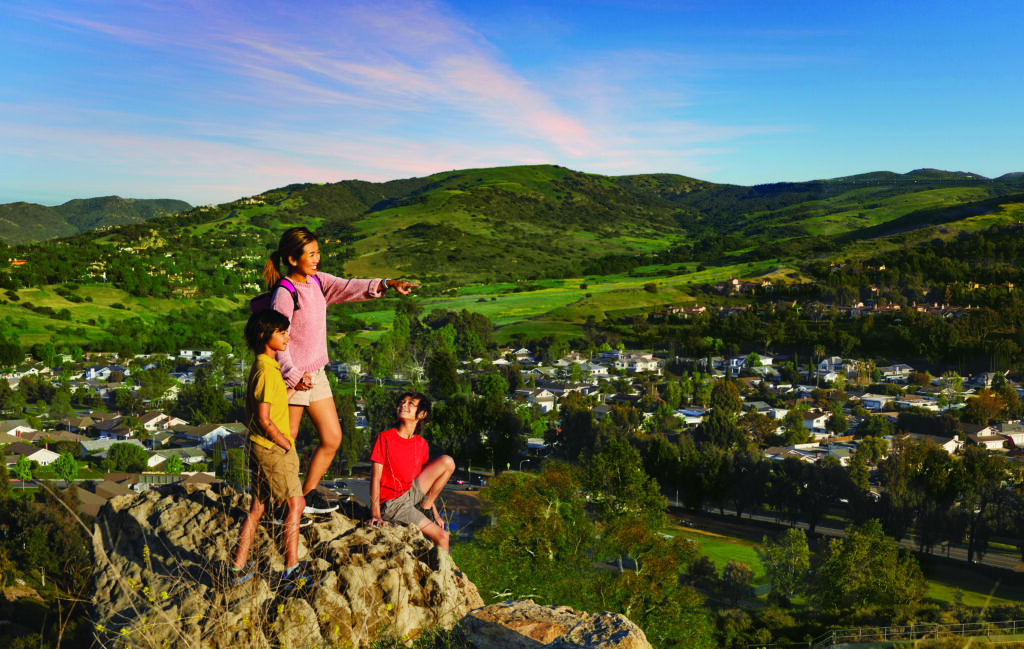
TO YOUR HEALTH
Parks offer important health benefits to the Irvine community
Irvine residents are exceptionally healthy, according to several surveys, and one likely reason lies outdoors, in the city’s more than 270 parks and tens of thousands of acres of permanently preserved open space.
Spending time in nature is good for both your body and mind – so much so that some scientists say it should become a habit, just like brushing your teeth. Of course, it helps if the toothbrush is close at hand.
“Not everyone can travel to remote wilderness, and it’s actually not really necessary, says Lisa Nisbet, associate professor of psychology at Trent University in Canada. “Just getting outside in a park for a few minutes a day can really lift your mood, and who doesn’t want to be happier?
Nisbet is one of dozens of researchers throughout the world who’ve been compiling evidence of nature’s health-enhancing gifts. These include not just the obvious physical ones, such as fresh air, cool shade, and opportunities to exercise, but a surprising array of mental and emotional benefits. Dozens of studies suggest that even brief but regular amounts of immersion in natural settings can improve people’s health, lowering blood pressure, reducing anxiety and depression, and improving concentration.
The benefits of grassy knolls and sunset strolls
There’s every indication that Irvine residents are taking advantage of the sights and scents of the city’s woodlands and lakes.
Remote workers bring their laptops to grassy knolls along the Jeffrey Open Space Trail. Newlyweds pose under sycamores along an adjacent creek. Couples take sunset strolls around the 9-acre lake at Mason Regional Park in the heart of the city, while hikers explore the park’s 123 acres of wilderness trails.
“Irvine spends more on its park system than almost any city in the country, which shows how much Irvine cares about ensuring the health and welfare of its residents, says Will Klein, the project manager for parks research at the Trust for Public Land. The national nonprofit has repeatedly ranked Irvine in the top 10 of the 100 largest U.S. cities, based on acreage, upkeep and other factors.
Healthy environments are by design
The city’s green spaces were indeed designed with residents’ health in mind, says Irvine Company landscape architect Richard Roy. The team that planned the Jeffrey Open Space Trail, which features an irregular creek-bed path made of decomposed granite, was inspired by New York’s Central Park, one of America’s first major attempts to offer urbanites peaceful green havens for quiet contemplation, Roy says.
“It’s still very rare in suburban settings to be able to experience natural landscapes like this, he says.
Inspired in part by scientists’ findings, government leaders throughout the world are becoming more interested in expanding and maintaining “green infrastructure. The United Nations has set a goal of providing universal access to safe and accessible public green spaces by 2030.
Lucky Irvine residents won’t have to wait. Says Klein, at the Trust for Public Land: “No matter where you live in Irvine, almost everyone has a park within a 10-minute walk from home.
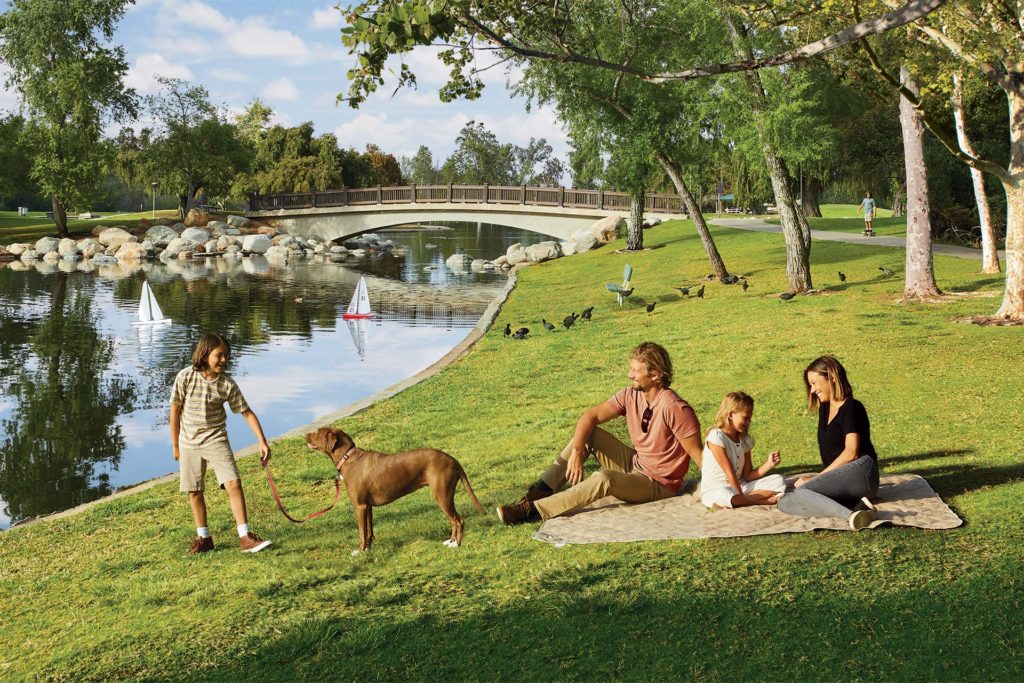
“Irvine spends more on its park system than almost any city in the country, which shows how much Irvine cares about ensuring the health and welfare of its residents.”
–WILL KLEIN, TRUST FOR PUBLIC LAND
“My wife and I recently discovered the formal gardens at Bill Barber Park. What a hidden gem.”
Matthew Inouye
13 COL. BILL BARBER MEMORIAL PARK
Beautiful ballparks and gardens
There’s something for everybody here with playgrounds, formal gardens and championship ballfields. Hold a birthday party or relax under a canopy of bougainvillea by a fountain. If you’re up for an adventure, jump on the adjacent Mountains to Sea Trail for a 5-mile ride to Upper Newport Bay.
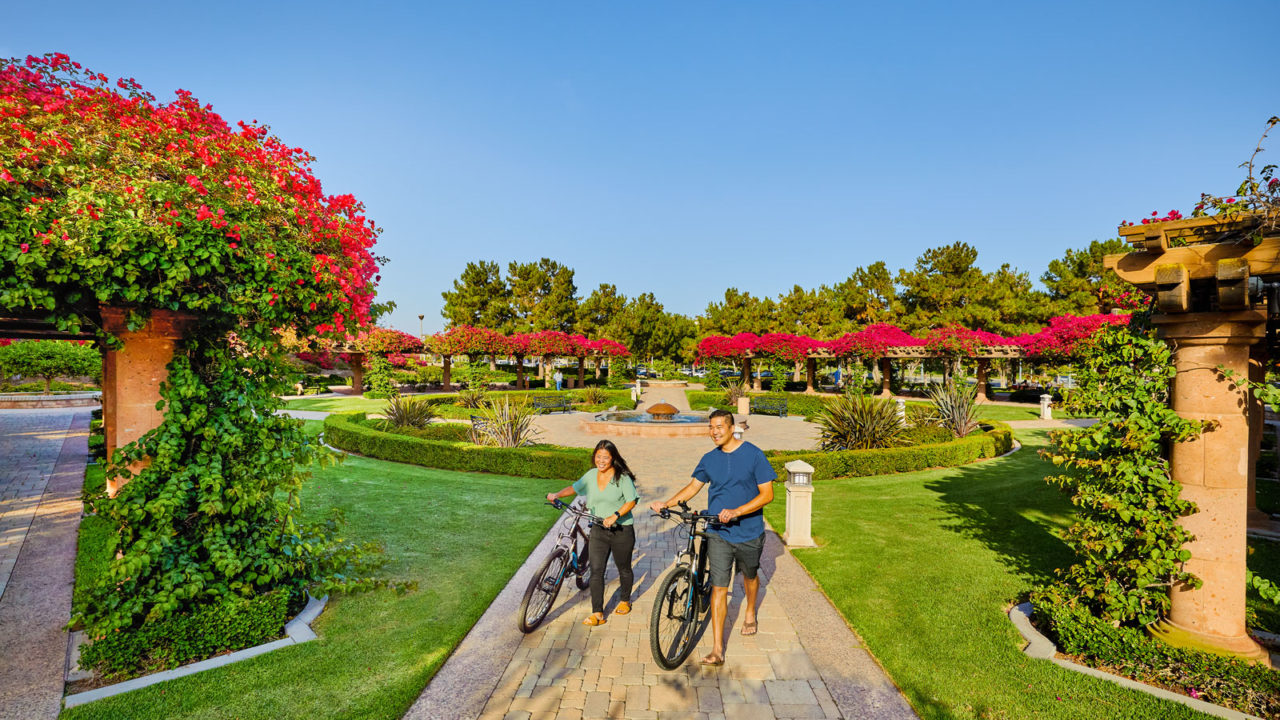
Jennifer Matsumoto and Matthew Inouye at Col. Bill Barber Memorial Park
14 STONEGATE NEIGHBORHOOD PARK
Designed for the neighborhood
Consider Bommer Meadow your warm-up to longer hikes deep into the 4,000-acre Bommer Canyon (some hikes take you clear to the ocean). This relaxing loop trail meanders through native grasslands. In the spring, California poppy, wild hyacinth, indian paintbrush and tidy tips burst into bloom.
15 IRVINE RANCH HISTORIC PARK
Experience the history of Irvine
Visit the site where James Irvine II managed the world’s largest bean field and grew so many Valencia oranges that it gave Orange County its name. Irvine Ranch Historic Park, near The Market Place, includes 24 original ranch buildings dating to the 1800s and an exact replica of the 1876 Irvine family home – now the Katie Wheeler Library.
16 DEERFIELD COMMUNITY PARK
Try a game of disc golf
Deerfield stands out for its well maintained disc golf course. The 9-hole, par 27 course is described by UDisc as a “challenging layout to test players’ length, shot selection, and disc control. The park also offers tennis, racquetball and volleyball courts and, through its community center, classes in cooking, science and tennis.
17 IRVINE CENTRAL PARK
Dog park is 4-legged fun
The city’s Central Bark dog park, which opened in 2000, is bigger and grassier than most dog parks in the county. It features 3 acres of open field for off-leash play, with one yard for big dogs and another for small dogs. The fully accessible park includes a watering facility for dogs, covered seating and lighting. The park is closed Wednesdays for maintenance.
18 PORTOLA SPRINGS COMMUNITY PARK
Tennis and pickleball
Opened in 2019, the park offers commanding views of the city as well as 32 acres of lighted ballfields, sports courts, playgrounds and a community center. Sign up the kids for dance, music and educational programs, or try some adult pickleball lessons. “It’s like we’re out in the country, Francine Verbarg said after her first visit. “It’s a public park, but it feels like a private club.

19 SETTLERS PARK
Play in the hills of Irvine
This beautifully landscaped, tree-lined park in Orchard Hills features two lighted, full-size basketball courts, sand volleyball and a huge soccer field for athletes, and a modern playground for kids. The shaded play area offers interactive gym equipment, climbing walls, rope climbers and separate play structures for older and younger kids.
20 MASON REGIONAL PARK
Irvine’s own Central Park
Consider this Irvine’s version of New York’s Central Park: a 2-mile stretch of trees, trails, playgrounds and a charming lake with model sailboats. Moms push strollers; couples practice yoga; children wave to ducks; and turtles sun on the rocks.
The park’s generous picnic shelters (one accommodates 500 people) are popular on weekends and holidays. And the lake’s footbridge is a favorite for family portraits.
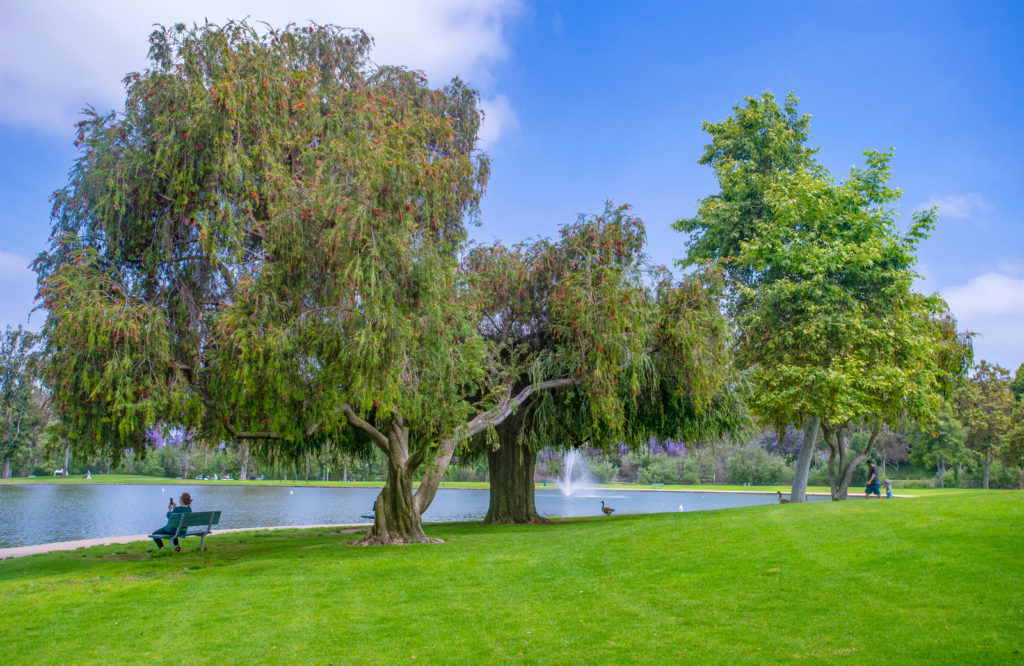
21 SEPULVEDA VISTA POINT
Ocean views and breezes
At 1.3 acres, this may be one of the smallest parks in Irvine, but it’s also one of the most breathtaking. Drive right up to this hilltop perch, and you can feel the ocean breeze in your face and see Catalina rising from the Pacific. On a clear day, you can look up the coast at Palos Verdes, while behind you lies the city of Irvine and the San Gabriel Mountains. Enjoy the view.
22 LOS OLIVOS COMMUNITY PARK
Make music with your kids
Engage your child’s imagination at the playground’s music station, featuring a toy xylophone and bongos. Athletes can play baseball, basketball or tennis under the lights, while children can enroll in dance, guitar and science camps at the community center. Want to go exploring? The park connects to the San Diego Creek Trail, which connects to the ocean.
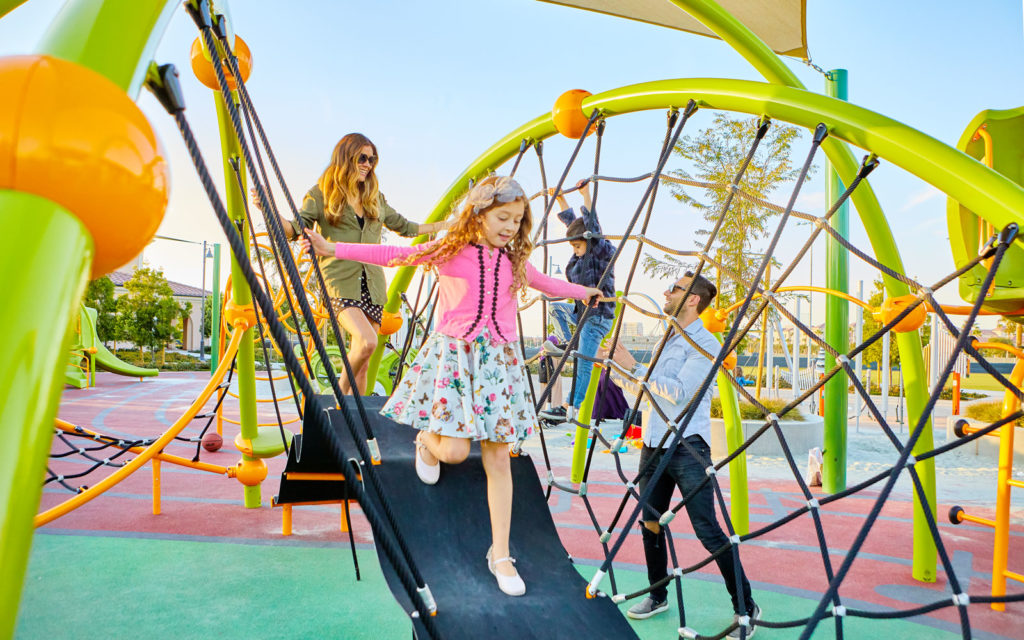
How Irvine’s Master Plan Created a City of Parks
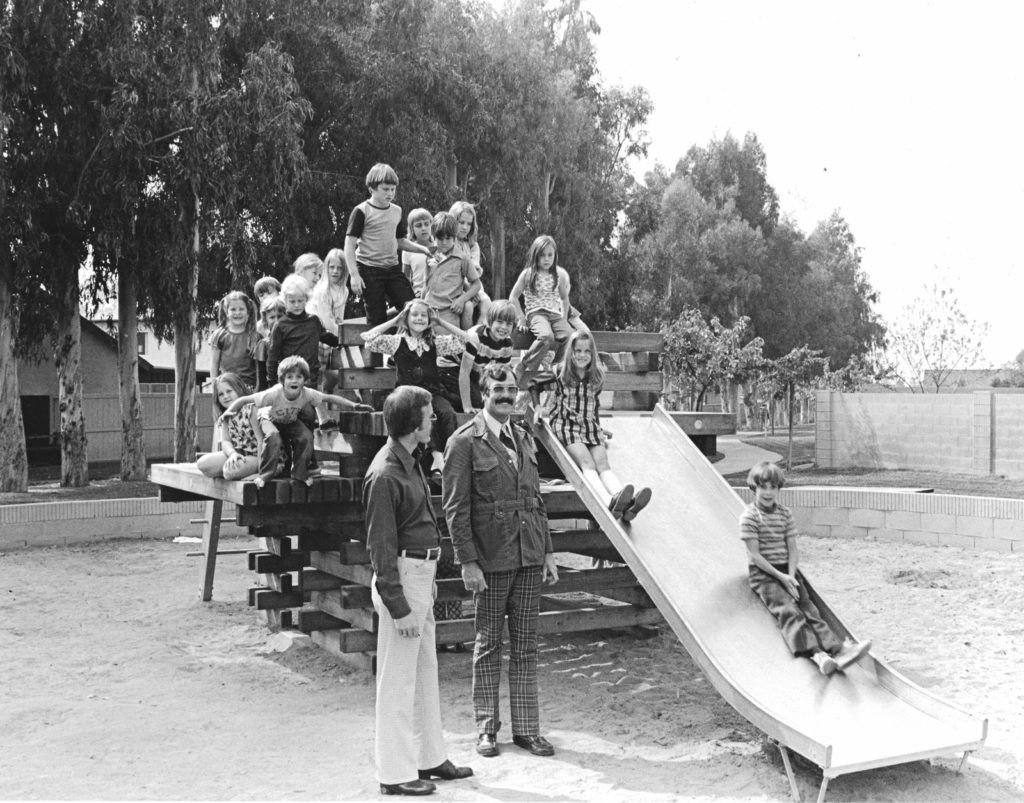
Parks provide some of the most memorable moments in American cities. San Francisco’s Golden Gate Park has forests, lakes, recreation fields and rose gardens. New York’s Central Park is a green oasis in the middle of Manhattan’s concrete canyons. Boston, Chicago and Philadelphia also built convenient, well-planned green space and recreation areas near the front doors of millions of city dwellings since the 19th century.
That’s the spirit that Irvine revived in the 1960s when the Irvine Company and architect/planner William Pereira master-planned our all-new city. If most new suburbs were largely asphalt, concrete and parking lots, Irvine’s parks would provide “relief from the confinement of the buildings, pavement, automobiles and noise of the city, Pereira wrote then.
Learning from the best, Irvine’s parks echo the lessons of the great American landscape designer Frederick Law Olmsted. Like his Central Park, Mason Park’s winding paths, scenic lake views, playgrounds, meadows and groves blend active recreation with relaxing natural vistas.
But Pereira also updated Olmsted’s vision. America’s grand 19th-century parks had been “pleasure grounds designed for carriages and formal promenades. Irvine’s parks would reflect the 20th century’s informal lifestyle with skateboard parks, barbecues and swimming pools.
Instead of placing one enormous park in the middle of the city (like Central Park), Irvine’s planners distributed parkland throughout the city. Calculating the demand in each neighborhood before a shovel of dirt was turned, Irvine wove its parks into the city’s fabric. Parks ranged in size from small village parks for family picnics (a quick walk from most homes) to large community and regional parks big enough for outdoor concerts and festivals.
Pereira initially stipulated 10% of Irvine’s land would go to parks. Today, it’s closer to 35%.
Thanks to Irvine’s Master Plan, parks large and small are an essential part of Irvine’s character.
Irvine resident Alan Hess has authored 20 books on architecture and community planning and is researching another on the Irvine Master Plan. He is an architect, a commissioner on the California State Historical Resources Commission, and was a National Arts Journalism Program Fellow at Columbia University’s School of Journalism.
